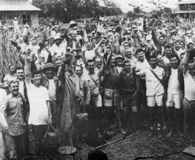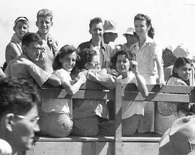Comparing the Osama bin Laden Raid and World War II Raids
 American Special Operations During World War Two
American Special Operations During World War Two
When John Brennan, the White House’s counterterrorism advisor, said that we would have to look back as far as World War II to find a special operations mission as daring as the one that took out Osama bin Laden, my mind immediately went to work. The Second World War was so vast in scope, geography, numbers that the challenge isn’t in finding daring raids—it’s in narrowing the list down to try to find something comparable.
To try to gain some limits in scope the first thing I did was reach for William H. McRaven’s book Spec Ops. McRaven is presently a US Navy Vice Admiral in charge of SEAL operaions in Afghanistan and his book is an interesting look at the theory of special operations. The theories are his own and were formulated differently than US military doctrine. Nevertheless the insight he provides is useful. His definition of a special operation is one that consists of a military unit usually trained or acting on a specific combat engagement. He cuts out the broader US military doctrine, which could include psychological operations, civil affairs, or recon.
{default}By using that definition we are deprived of some excellent operations—Merrill’s Marauders, the Chindits, the Airborne operations during D-Day—each excellent examples of elite units. But these units were operating continuously in theater for extended operations, not specific objectives. As I reached for books off my library shelves I also wanted to contain my examination to the Second World War.
The Second World War was a global conflict by every definition. Conflict took place on a global scale, on every type of terrain, in every type of weather. From icy mountaintops to steamy jungles, assaults were launched from the air, the sea and the land. The history of special operations matches this scope.
There have been a number of impressive special operations missions conducted since World War II, notably the Israeli raid on Entebbe airport, but World War II was a time when special operations units using modern weapons and equipment were in their formative stages. Shaped charges, aerial insertion, automatic weapons; each of these was lending itself to new and innovative methods of implementation. It is fascinating to see how such technologies were adapted to overcome obstacles which some might have previously considered insurmountable.
This article covers only two special operations missions performed by American forces. I have a dozen books at my side which cover a number of mission and that is doubtless not even scratching the surface. Some books are redundant; a few are special looks at one raid while others cover more general operations. To compile a properly exhaustive list would likely require an investment in research that would result in a book. Instead it is my intention to create a starting point from which an interested reader may begin to look further. A bibliography of suggested starting titles rests at the bottom of each page under the Recommended section.
Two American Special Operations
 Cabanatuan Prison Camp
Cabanatuan Prison Camp
American special operations during World War Two bring two missions immediately to mind. Both were conducted within about a month of one another, took place in the Philippines, and were aimed at rescuing prisoners of war. The hell these prisoners endured is difficult to overstate. Some POWs suffered through the infamous Bataan Death March, others did not, but regardless of how they arrived at their POW camp, conditions in the camps were inhumane. Inadequate food, water, and medicine made death a daily occurrence. Sadistic treatment by many Japanese soldiers compounded the misery. Years passed before the United States was able to mount a campaign to retake the Philippines. As bad as conditions were on a daily basis, as US forces approached the POW camps the Japanese began evacuating the prisoners at Cabanatuan to be used as slave labor. About 500 POWs remained in late January 1945. These were the most ill. American commanders feared that those remaining POWs would soon be executed.
As a result, US commanders quickly formulated plans to liberate these camps. The results were two daring raids in which forces infiltrated behind the lines to rescue the POWs. The first took place at Cabanatuan, where Army Rangers aided by Filipino guerillas marched 20 miles through thick jungle to release the prisoners. Characterized by good intelligence provided by Filipino guerillas, the raid achieved complete surprise, lasted about 30 minutes and resulted in the successful rescue of men who feared they had long been forgotten—a resounding success.
 Los Baños Prison Camp
Los Baños Prison Camp
The second raid took place at Los Baños less than a month later. Reports that the Japanese were killing both civilians and prisoners of war were filtering in, and again a plan was formulated to rescue the prisoners at Los Baños. By February 20, 1945, Allied forces near the area had achieved a sufficient level of supremacy to allow elements of it to be broken off and assigned to liberate the POW camp. Again working closely with Filipino guerrilla groups, US forces were able to obtain good intelligence about the disposition of Japanese forces in the area. Braving the threat of death for escaping, two POWs from Los Baños managed to slip out to provide intelligence about the inside of the camp. Both then returned to the camp.
This time the plan had multiple avenues of assault. One unit, the 11th Airborne’s Provisional Reconnaissance Platoon assisted by 20 Filipino guerillas would infiltrate behind enemy lines by boat. A second force would then drop by parachute near the camp. A third force of 54 LVT tracked amphibious vehicles would then land and move to within three kilometers of the camp in preparation for the extraction of the POWs. A fourth element would move down the main highway and act as a diversionary force to attract Japanese attention. A fifth force, comprised of Filipino guerillas, set up roadblocks to slow any possible reinforcements that might attempt to reinforce the existing Japanese troops.
The Los Baños raid was again a resounding success. Casualties were light, and over 2,100 POWs were rescued. When Japanese forces visited the area a few days later and discovered no prisoners were left, they turned their wrath on the local population, murdering 1,500 Philippine civilian men, women, and children in retaliation. The Japanese commander responsible for this war crime was later hanged for his action after a trial.
* * *
Both of these American special operations have parallels with the raid to kill Osama bin Laden. They were successful due to excellent intelligence. They achieved total surprise and used overwhelming force to subdue the enemy. Having achieved total domination over their target they quickly achieved their objective. Speed, superior firepower, and surprise characterized these actions, and they laid the groundwork for future special operations forces to build upon. If there is one contrasting element it is that during World War II local Filipino guerillas were highly supportive of US troop. They provided excellent intelligence, reconnaissance, and guidance to the POW camps. Quite a contrast, indeed.
Click here to read an Armchair General exclusive, A Filipino Guerilla’s Story.
Editor’s Note: On April 27, 2011, survivors of the Los Baños camp and members of the 11th Airborne Division gathered at the Philippine Consulate Center in New York City for a reunion.

